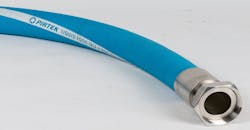Don't Let Hose Failure Halt Your Production Process
Manufacturing is a vibrant economic force in the United States, adding trillions of dollars to the economy every year. U.S.-manufactured goods have quadrupled in the last 25 years, according to the National Association of Manufacturers.
But in this burgeoning industry, much depends on the little things – for example, the soundness of a hose.
Imagine an assembly line flanked by robotic arms with their jerky, coordinated movements, welding and painting pieces that move through the process. It’s a technologically impressive system, often involving artificial intelligence. But one hydraulic hose failure can suddenly put a brake on the entire operation. The “smart” factory of the future isn’t so smart when it’s at a standstill.
This can be an expensive accident. Often, it’s entirely preventable.
Check out your hoses and joints
Being proactive in this regard can save a factory a lot of time and money. That means checking your hydraulic and pneumatic hoses, making it a scheduled maintenance activity.
A visual check can catch problems before they immobilize your operation. It’s a simple process: First, make a checklist and tick off each item on the list. Begin your inspection by examining the exterior of each hose. Look for cuts in the hose’s cover, along with other telltale signs of wear. One obvious sign is when the wire reinforcement is showing. Some hoses also kink with age. When any of these “red flags” is evident, be sure to schedule a hose replacement during the equipment’s downtime.
Note, too, that you can shield your hoses from the ravages of wear by covering them with protective sleeves. These come in metal coils, textile, plastic and other materials. They can be worth the investment, extending the life span of your hoses.
Problems on the inside
If you don’t find problems on the external surfaces of your hoses and joints, that’s a relief. But it doesn’t necessarily mean all is well. Sometimes there’s damage inside a hose, even when the outside shows no evidence.
Such damage is usually the result of contaminants in the fluid. Erosion dislodges particles from valves and pumps over time. These contaminants tear up the inside surface of a hose as they course through the system, acting like tiny blades.
Unfortunately, your visual inspection is unlikely to uncover such issues going on inside your hoses. That’s why it’s so important to make sure your oil and other fluids are changed on a regular basis. Equally important is replacing filters at scheduled intervals to ensure that any loose particles are effectively screened out.
Check the fittings
Once you’ve checked the hoses, make sure they’re compatible with the fittings. While it’s ideal when hoses and fittings all come from the same manufacturer, this is often not the case. If your hoses and fittings are mixed brands, check them out to make sure they’re in sync with one another. The manufacturer’s information should be visible. A good hose vendor will tag the hoses after replacing them, allowing you to check easily for hose-to-fittings compatibility.
You should also look over your fittings for potential problems. There should be no oxidation, rust or moisture at the joints. If you see any of this, consider replacement.
Preventing trouble
Preventative maintenance can have far-reaching effects, so take the necessary steps. Don’t let something as small as a hydraulic hose failure cost your factory a sizable sum. Schedule regular checks and follow up with any issues you find. You’ll be glad you did.
The robots may even thank you.
Craig Heitkamp owns PIRTEK Midway in Midway, MN, and PIRTEK Plymouth in St. Paul, Minn.
About the Author
Craig Heitkamp
Owner
Craig Heitkamp owns PIRTEK Midway in Midway, MN, and PIRTEK Plymouth in St. Paul, MN.
